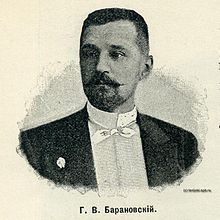Loading AI tools
From Wikipedia, the free encyclopedia
Gavriil Vasilyevich Baranovsky, also Baranovskii (Russian: Гавриил Васильевич Барановский; 6 April [O.S. 25 March] 1860 – 28 June 1920)[1] was a Russian architect, civil engineer, art historian and publisher, who worked primarily in Saint Petersburg for the Elisseeff family, but also practiced in Moscow and produced the first town plan for Murmansk (then Romanov-na-Murmane).
Gavriil Vasilyevich Baranovsky | |
|---|---|
 | |
| Born | 6 April [O.S. 25 March] 1860 |
| Died | June 20, 1920 (aged 60) Kellomäki, Finland |
| Nationality | Russian |
| Occupation | Architect |
| Buildings | Elisseeff Buildings, Saint Petersburg |
| Projects | First town plan for Murmansk, 1917 |
This article includes a list of general references, but it lacks sufficient corresponding inline citations. (August 2023) |
He was born in Odessa to attorney Vasili Ivanovitš Baranovsky and his wife Rosalia Malinovska Gavriil Baranovsky. Baranovsky trained at Saint Petersburg Institute of Civil Engineers (1881–1886), graduating with an honorary silver medal. He began his architectural career as an assistant to Paul Susor (Pavel Susor) between 1883 and 1885. His first commission was a state-financed Main Palace Chancellery (Главная дворцовая канцелярия); in 1885-1888, Baranovsky worked on numerous apartment buildings in Saint Petersburg. After 1888 he became staff architect for the Baltic Shipyards.
Baranovsky was married to a daughter of Grigory Elisseeff of the Elisseeff (Yeliseyev, Elisseieff) merchant family based in Saint Petersburg, owner of a lot of local real estate. Grigory Elisseeff's apartment building (1889–1890) became Baranovsky's first independent commission as a lead architect. Later, Baranovsky completed various country homes for the Elisseeff family and, most visible of his buildings, an eclectic Elisseeff Emporium on Nevsky Prospect (1900–1903) and its Moscow counterpart, the Elisseeff Store on Tverskaya Street (1898–1901, with Marian Peretyatkovich). In 1898 Baranovsky was appointed construction manager for all Elisseeff businesses.
Baranovsky's style varied through different shades of eclectics, eventually focusing on Art Nouveau.
In 1891 Baranovsky was appointed to Empress Maria's Office of Charitable Institutions and designed Saint-Petersburg Eye Hospital. He also held various consultancy roles with other state institutions. More important was his public editorial activity, starting as chief editor of Our Home (Наше Жилище, 1894–1895), later Stroitel (Строитель, 1895–1905) magazine. Baranovsky promoted and edited the "Architectural Encyclopaedia of the Second Half of 19th century" ("Архитектурная энциклопедия второй половины XIX века") in seven volumes. It was then considered to be the most complete Russian reference on contemporary architecture of the world.
According to St. Petersburg Fragments (Петербург - фрагменты) Biographical section, the aging architect died in 1920 from starvation that followed the Russian Revolution of 1917 and the Russian Civil War. Baranovskys son Wassilij (d. 1945) immigrated to Sweden. He was pianist and composer and made several recordings in his new homeland. He was married with violinist Nora Duesberg.

Seamless Wikipedia browsing. On steroids.
Every time you click a link to Wikipedia, Wiktionary or Wikiquote in your browser's search results, it will show the modern Wikiwand interface.
Wikiwand extension is a five stars, simple, with minimum permission required to keep your browsing private, safe and transparent.